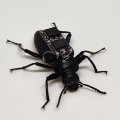University of Queensland scientists have developed the world’s first 3-D environment simulating the disabling mental illnesses known as psychosis.
The proof-of-concept project aims to improve understanding, and potentially treatment, of this disorder affecting one to two percent of the population at some time in their lives.
Patients with psychosis claim an estimated 12-16 percent of Australian hospital beds. Tragically, suicide is common among people with this illness, which often strikes people in their prime. Symptoms include delusions, hallucinations, and thought disorder. Most people with psychotic symptoms "hear" voices, and a large proportion also "see" visual illusions.
Currently, patients have to describe their symptoms to their therapist, as there is no way for the therapist to share the experiences or objectively evaluate them. Consequently, patients often feel that their therapists cannot really understand them, and the therapists themselves have difficulties learning about the exact nature of psychosis as they have no personal experience of it.
Manager of the University’s VR Centre (ViSAC) Andy Dennison said the project aimed to create a virtual environment, artificially modelling the experience of psychosis. The technology made it easier for the medical profession, carers and family members to understand the experiences of patients.
Researchers from the University’s Centre for Online Health and the Advanced Computational Modelling Centre collaborated on the project. It models an everyday environment — a living room — and overlays it with some of the frightening experiences patients say they have suffered, such as hearing audio illusions of voices ranging from whispers to a cacophony.
The researchers have used techniques such as morphing and 3D enhancement of objects to reflect the visual illusions that patients with psychosis might experience.
Mr Dennison said that further down the line it was hoped this technology could be be used for diagnostic work and for treatment of illness.
“It will be possible to develop realistic virtual environments in which patients can recreate their experiences using photos of their homes or hospital rooms, and dropping in hallucination scenarios which they describe have happened to them,” he said.
“Our first patient will be assisting us this month on the project. This is the first known example of VR psychosis, a major advance on some previous video and film representations of the disorder.”
The project is the brainchild of the Director of the Centre for Online Health, Professor Peter Yellowlees, who approached the Director of the Advanced Computational Modelling Centre Professor Kevin Burrage. A team including Dr Jasmine Banks, Mr Dennison, Dr Geoff Ericksson, Dr Derek Fernandez and Sean Ivermee are extending the original concept.
Pharmaceutical company Eli Lilly has provided a three-year $180,000 development grant and the researchers hope to attract further funding in the 2003 Australian Research Council round.
Media: Further information, contact Andy Dennison, telephone (07)3364 0601, Mobile: 0412 455 945, email: a.dennison@qmisolutions.com.au, Professor Peter Yellowlees, telephone 07 3365 4671, email p.yellowlees@mailbox.uq.edu.au or Professor Kevin Burrage, telephone 07 3365 3487, email: kb@maths.uq.edu.au
.jpg)

